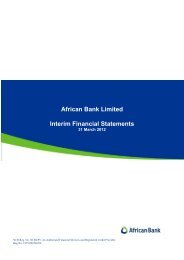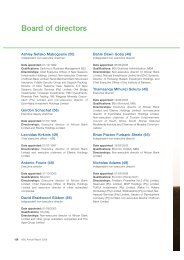Download - African Bank
Download - African Bank
Download - African Bank
You also want an ePaper? Increase the reach of your titles
YUMPU automatically turns print PDFs into web optimized ePapers that Google loves.
Notes to the annual financial statements<br />
for the year ended 30 September 2003<br />
1. ACCOUNTING POLICIES<br />
The annual financial statements of the group are prepared as a going concern on a historical cost basis, except for certain financial<br />
assets and liabilities that are measured on a fair value basis in terms of AC133 – Financial Instruments: Recognition and<br />
Measurement. The consolidated financial statements conform to South <strong>African</strong> Statements of Generally Accepted Accounting<br />
Practice and the Companies Act of 1973. The following principal accounting policies have been consistently applied, except for<br />
changes implemented due to AC133 which was introduced with effect from 1 October 2002. This new statement is a prospective<br />
statement which does not require a restatement of comparatives. The introduction of AC133 had an immaterial impact on the<br />
financial statements as a whole as ABIL has in the past made provisions for impairments on a similar basis to that contemplated in<br />
AC133. The only change to the balance sheet has been the removal of the general provision, and the introduction of a portfolio<br />
provision which approximates the minimum provision required by the <strong>Bank</strong>s Act for performing loans. This had an immaterial impact<br />
on the income statement.<br />
1.1 Consolidation<br />
The group annual financial statements incorporate the annual financial statements of the company and its subsidiaries.<br />
The operating results of the subsidiaries are included from the effective dates control is acquired and up to the effective dates of<br />
disposal. All significant inter-company transactions and balances have been eliminated. Premiums or discounts arising on the<br />
acquisition of subsidiaries are treated in terms of the group’s accounting policy for goodwill.<br />
1.2 Goodwill<br />
Goodwill arising on consolidation represents the excess of the cost of acquisition over the group’s interest in the fair value of the<br />
identifiable assets and liabilities of a subsidiary, associate or jointly controlled entity at the date of acquisition. Goodwill is<br />
recognised as an asset and amortised on a systematic basis following an assessment of the foreseeable life of the asset, subject to<br />
a maximum of 20 years.<br />
The carrying amount of goodwill is reviewed annually and written down for permanent impairment where it is considered necessary.<br />
Negative goodwill, which represents the excess of the group’s interest in the fair value of the identifiable assets and liabilities<br />
acquired over the cost of acquisition, is eliminated proportionately against the fair values of the non-monetary assets acquired.<br />
On disposal of a subsidiary, associate or jointly controlled entity, the attributable amount of unamortised goodwill or negative<br />
goodwill is included in the determination of the profit or loss on disposal.<br />
1.3 Joint ventures<br />
A joint venture is a contractual agreement between the group and another party to undertake an economic activity, which is subject<br />
to agreed sharing of control, in which the group has a long-term interest.<br />
Investments in joint ventures are accounted for on the proportional consolidation method, whereby the group’s proportionate share<br />
in assets, liabilities, revenue, expenses and cash flows of the joint venture are combined on a line-by-line basis with similar items in<br />
the consolidated financial statements.<br />
A proportional share of intra-group transactions and balances is eliminated. The results of the joint venture are included from the<br />
effective date of acquisition and up to the effective date of its disposal.<br />
1.4 Associates<br />
Associates are those enterprises in which the group holds an equity interest and over which it has the ability to exercise significant<br />
influence and which are neither subsidiaries nor joint ventures.<br />
Investments in associated companies are accounted for in the group financial statements using the equity method, for the duration<br />
that significant influence is exercised by the group.<br />
<strong>African</strong> <strong>Bank</strong> Investments Limited 100







